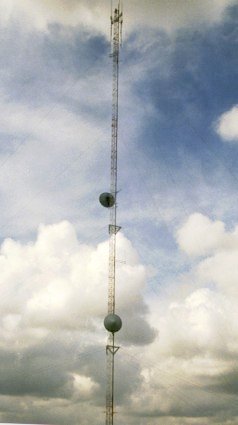Radio Towers
Today, a new tower and a new metaphor. The University of Houston's College of Engineering presents this series about the machines that make our civilization run, and the people whose ingenuity created them.
Try this: Towers have always been metaphors for communication. Lighthouses tell of a rocky shore. Minarets tell the hours of prayer. Steepled churches, visible for miles, were the Medieval communication centers. The towering elevators of the grain-growing towns of the 19th-century Midwest were spaced out along the railway tracks, announcing each whistle-stop.
The Tower of Babel is our metaphor for failed communication. Different towers tell of different things in every age. Today, skyscraper towers, power-line towers, all reach upward. So which tower speaks to us -- and what does it have to say?
Architect Michele Bertomen studies the view from the sprawling Long Island Expressway and offers her answer. What she sees are antenna towers. Let's see how they work.
AM radio goes out on fairly low frequencies -- from half to 1.7 megahertz. AM wavelengths run from 200 to 600 meters. Long waves like that bounce off the ionosphere and travel very far. With the right radio you can pick up signals from China.
My FM station, KUHF in Houston, airs at 88.7 megahertz. It gives a far clearer signal than AM, but its wavelength is only 11 feet. It travels in an almost straight line. Our antenna has to sit on a huge tower -- 1640 feet high. The signal reaches a horizon some 60 miles away. Beyond that radius, it rapidly dies out.
Television, radar, telephone, and FM radio all ride on microwaves, and they all follow approximate line-of-sight paths. So a new metaphor for communication -- the microwave transmission tower -- rises among us.
You see those tall, spindly ladders of structural steel everywhere these days. They're oddly unimposing, considering their size; and they've crept into our midst almost unnoticed.
Michele Bertomen drives Long Island and records 17 towers, most of them over 300 feet tall. They're modest compared with ours, but still longer than a football field. They're slim and delicate -- festooned with antennas. They have the odd grace of any really good piece of design.
And the metaphor is more powerful than ever today. Our lives are wed to these great communications beacons. Poet Robert Coffin catches their meaning when he describes light houses:
If men could still be holy anywhere,
It would be in towers such as these
That line the coasts with lamps and warn the ships --
The holy towers of silences.
Whether these towers bring a measure of holy quiet, or a torrent of messages, into our lives is ours to decide, of course. In the end, the way we use the metaphor -- remains our choice.
I'm John Lienhard, at the University of Houston, where we're interested in the way inventive minds work.
(Theme music)
Bertomen, M., Transmission Towers On the Long Island Expressway: A study of the Language of Form, New York: Princeton Architectural Press, 1991.
I am grateful to Margaret Culbertson, Head of the UH Art and Architecture Library, for suggesting the topic and providing the Bertomen source; to Stuart Long, Chairman of Electrical Engineering at UH for his counsel on signal transmission; and to David Knodel of KUHF for explaining how this all works at our radio station.

Photo by John Lienhard